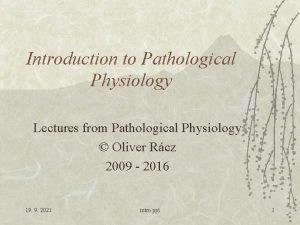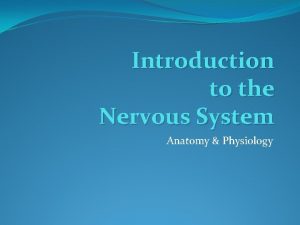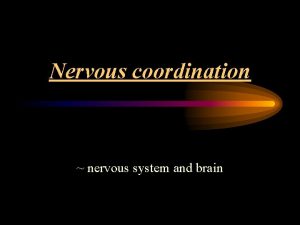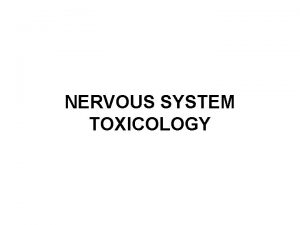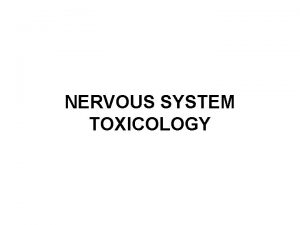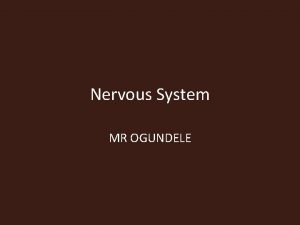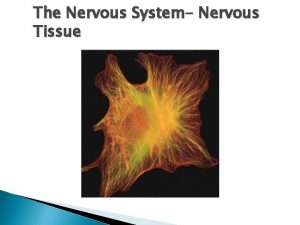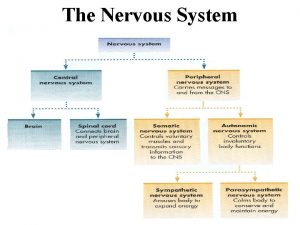The Nervous System Anatomy and Physiology and Pathological








































- Slides: 40

The Nervous System Anatomy and Physiology and Pathological Conditions

The Nervous system is similar to: A Computer! The Brain and Spinal Cord plus many nerves extending throughout the body are very much like a computer. Both are designed to send and receive signals.

Watching the Brain “light up” Neurologists and scientists who specialize in studying the brain can take pictures of the brain of a person who is involved in various activities. “Brain mapping” attempts to relate the brain's structure to its function, or finding what parts give us certain abilities. (Nasr, Susan. “How the Brain Works”)

What Techniques/Procedures are used? � “Brain mapping is a collection of many different tools. Researchers must collect images of the brain, turn those images into data, and then use that data to analyze what happens in the brain as it develops. ” � (Nasr, Susan. “How the Brain Works. ”) � Positron Emission Tomography (PET) takes images of radioactive markers in the brain � Computer axial tomography (CAT) scan X -rays the brain from many angles and show structural abnormalities.

What Techniques/Procedures are used? � Electroencephalography (EEG) indicates electrically active locations in the brain using detectors implanted in the brain or worn on a cap. � Transcranial magnetic stimulation (TMS) noninvasively stimulates parts of the brain to trigger certain behaviors. Functional MRI (f. MRI) shows images of brain activity while subjects work on various tasks � Pharmacological MRI (ph. MRI) shows brain activity as drugs are administered.

� Brain Mapping is unique and important because. . . …it shows what part of the brain is active during certain activities or thought processes.


Let’s learn about the anatomy of the human nervous system The nervous system is divided into two parts: the Central Nervous System (CNS) and the Peripheral Nervous System (PNS).

Central Nervous System Peripheral Nervous System What is it comprised of? Brain + Spinal Cord What is it comprised of? 12 pairs of cranial nerves and 31 pairs of spinal nerves. What does it do? Transmits sensory and motor impulses back and forth to the CNS and the rest of the body. What does it do? Processes and stores sensory and motor information and controls consciousness.

Brain Components Video: � http: //www. nlm. nih. gov/medlineplus/ency/anatomyvide os/000016. htm

Structures of the Human Brain � The brain is one of the largest organs in adult humans. It weighs approximately 3 pounds and reaches full size by the time a person turns 18 years old. (Jones 2009)

The major structures of the brain include: Cerebrum � Largest part, uppermost part of brain � Controls consciousness, memory, emotions, sensations, and voluntary movements

The major structures of the brain include: Cerebral Cortex � The surface of the Cerebrum

The major structures of the brain include: Cerebellum � Attached to the brain stem � Maintains muscle tone and coordinating normal movement and balance

The major structures of the brain include: Diencephalon � Located between the cerebrum and the midbrain. � Consists of several structures, including the thalamus, hypothalamus, and the pineal gland.

The major structures of the brain include: Brain Stem � Located between the Diencephalon and the spinal cord. � Consists of the midbrain, pons, and medulla oblongata. � Regulates breathing, heartbeat, and blood pressure.

The Spinal Cord � The Spinal cord is the pathway for impulses traveling to and from the brain. It carries 31 pairs of spinal nerves that affect the limbs and lower part of the body. The spinal cord is protected by cerebrospinal fluid, 3 -layer meninges, and the vertebral column. (Jones 2009)

Concept Review and Comprehension Check What are the two parts of the Nervous System called? (1) The Central Nervous System (CNS) and the Peripheral Nervous System (PNS) (2) The Central Nervous System and the Lateral Nervous System (3) The BNS and the PONS

� What is the largest part of (1) Cerebellum (2) Diencephalon (3) Cerebrum the human brain called?

� Identify one function that (1) Heart muscle tone (2) Heart beat (3) digestion the brain stem regulates:

� What is the brain similar (1) A typewriter (2) A football (3) A computer to?

Word Elements Relating to the Nervous System

Word Elements in Action An + algesia = analgesia: without sensitivity to pain A + phasia = aphasia: without speech; inability to speak Cephal/o + -algia = cephalalgia: pain in the head/brain Neur/o + -pathy = neuropathy: disease of the nerves

The Nervous System Pathological Conditions

Categories of Pathological Conditions Neurologists and Neurosurgeons deal with many different kinds of problems involving the brain and spinal cord.

Categories of Pathological Conditions � Most brain and spinal cord disorders are classified into one of the following categories: � Congenital disorders � Degenerative, functional and seizure disorders � Infectious disorders � Intracranial tumors � Traumatic disorders � Vascular disorders � Peripheral nerve disorders � Disk disorders

Congenital Disorders Example: Anencephaly Breakdown of word: an- without, not Encephal/0 = brain -y = (noun ending) What is it? A congenital disorder characterized by the absence of the brain and spinal cord at birth.

Seizure Disorders Example: Epilepsy Breakdown of word: Epi- over, upon -lepsy = seizure, attack What is it? A syndrome of recurring episodes of excessive irregular activity in the central nervous system.

Infectious Disorders Example: Shingles (Herpes Zoster” What is it? An acute viral infection involving inflammation of the spinal or cranial nerves that produces a painful skin rash.

Intracranial tumors (primary) Example: Glioblastoma Breakdown of word: Gli/o- gluey substance blast = embryonic stage -oma = tumor What is it? A malignant (cancerous) brain tumor that starts in the glial cells of the brain.

Traumatic Disorders Example: Cerebral Concussion What is it? A brief interruption of brain function caused by blunt trauma to the head. http: //www. nlm. nih. gov/medli neplus/ency/anatomyvideos/0 00034. htm

Vascular Disorders Example: Cerebrovascular Accident (CVA) What is it? Death of part of the brain due to decreased blood flow to that area. Also known as “stroke. ” http: //www. nlm. nih. gov/me dlineplus/ency/anatomyvi deos/000123. htm

Peripheral Disorders Example: Carpal tunnel syndrome What is it? A pinched or compressed nerve in the carpal tunnel passage of the wrist.

Disk Disorders Example: Degenerative disk What is it? Deterioration of the intervertebral disk, usually due to constant motion and wearing on the disk.

Concept Review and Comprehension Check Based on the context of the reading, what does the word Congenital mean? (1) From birth (2) A degenerative disorder (3) A brief interruption of consciousness

� Based on the reading, what is the best meaning of “vascular disorder”? (1) Pain in the wrist (2) Problems that arise in the cerebral cortex (3) Problems that arise in the blood vessels to the brain

� Which is an example of a virus affecting the nervous system? (1) Carpal tunnel syndrome (2) Shingles (Herpes zoster) (3) glioblastoma

� What can cause a Cerebrovascular Accident (CVA)? (1) Low blood sugar (2) A car accident (3) Decreased blood flow to part of the brain

Word Elements in Action AMy/o Troph/o -ic Scler/o -osis ----------------Amyotrophic (lateral) Sclerosis = ALS = Lou Gehrig’s Disease = Without, not Muscle Development Pertaining to Hard Condition ---------------A condition pertaining to lack of muscle development and hardening (of muscles) due to loss of motor neurons in brain stem and spinal cord

Small Group Activity You will work in small groups of 2 -3 people. I will give you a sticky note with a technique or procedure to demonstrate/explain to the class. � Use physical demonstration to show location of procedure. � Tell how to break down the word into definable parts. � Explain why this procedure is useful.
 Neuronal pools
Neuronal pools Sensory input and motor output
Sensory input and motor output Neuronal pools are collections of
Neuronal pools are collections of Anatomy and physiology unit 7 cardiovascular system
Anatomy and physiology unit 7 cardiovascular system Respiratory system
Respiratory system Anterior surface of scapula
Anterior surface of scapula Upper respiratory tract consists of
Upper respiratory tract consists of Tattoo anatomy and physiology
Tattoo anatomy and physiology Anatomy science olympiad
Anatomy science olympiad Crown plants examples
Crown plants examples Anatomy and physiology bones
Anatomy and physiology bones Pud triple therapy
Pud triple therapy Liver anatomy
Liver anatomy Epigastric region
Epigastric region Wpigastric region
Wpigastric region Straw colored fluid
Straw colored fluid Chapter 14 anatomy and physiology
Chapter 14 anatomy and physiology Endomysium
Endomysium Http://anatomy and physiology
Http://anatomy and physiology Waistline
Waistline Anatomy and physiology of appendicitis
Anatomy and physiology of appendicitis Aohs foundations of anatomy and physiology 1
Aohs foundations of anatomy and physiology 1 Aohs foundations of anatomy and physiology 1
Aohs foundations of anatomy and physiology 1 Anatomical planes
Anatomical planes Anatomy and physiology chapter 8 special senses
Anatomy and physiology chapter 8 special senses Chapter 13 anatomy and physiology of pregnancy
Chapter 13 anatomy and physiology of pregnancy Unit 26 animal anatomy physiology and nutrition
Unit 26 animal anatomy physiology and nutrition Science olympiad anatomy and physiology 2020 cheat sheet
Science olympiad anatomy and physiology 2020 cheat sheet Anatomy and physiology chapter 2
Anatomy and physiology chapter 2 Degluttination
Degluttination Anatomy and physiology of pancreas
Anatomy and physiology of pancreas Heat and cold
Heat and cold Anatomy and physiology coloring workbook figure 14-1
Anatomy and physiology coloring workbook figure 14-1 Chapter 10 blood anatomy and physiology
Chapter 10 blood anatomy and physiology Aohs foundations of anatomy and physiology 1
Aohs foundations of anatomy and physiology 1 Aohs foundations of anatomy and physiology 1
Aohs foundations of anatomy and physiology 1 Anatomy and physiology
Anatomy and physiology Anatomy and physiology chapter 15
Anatomy and physiology chapter 15 Cornell notes for anatomy and physiology
Cornell notes for anatomy and physiology Anatomy and physiology ninth edition
Anatomy and physiology ninth edition Anatomy and physiology chapter 1
Anatomy and physiology chapter 1









































